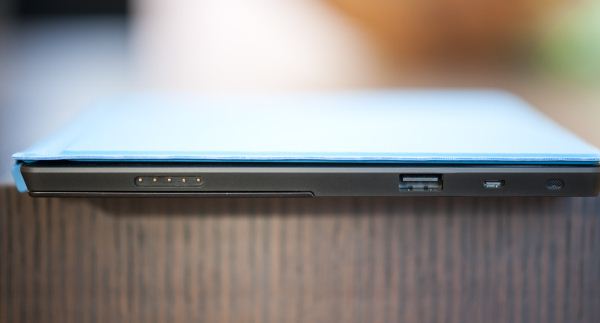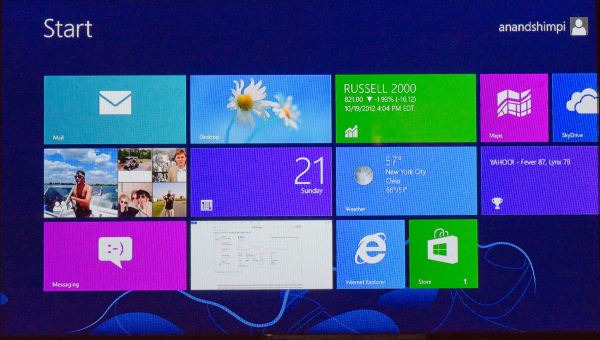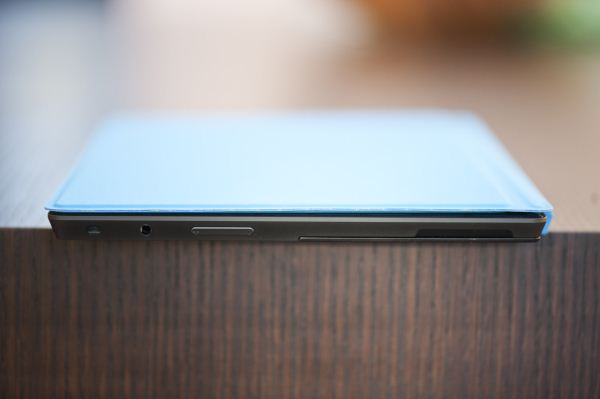Microsoft Surface Review
by Anand Lal Shimpi on October 23, 2012 9:01 PM EST- Posted in
- Tablets
- Microsoft
- Mobile
- Surface
- Windows RT
A Plethora of Ports and Storage Options
One area where Surface is a significant departure from the iPad is in its IO and expansion. The iPad features a single dock (and soon to be Lightning) connector, while Surface looks more like a laptop (or Android tablet) when it comes to IO.
There’s no port for syncing, you get content onto Surface via WiFi or a more traditional method. Surface has a single USB 2.0 port on the right side of the device. You can plug almost anything you want into this port, including USB storage devices of course. Behind the kickstand is a single microSD card slot, giving you another option for expansion.
On the left edge of the device there’s a micro-HDMI out port that can be paired with a Microsoft made VGA or HDMI dongle (both dongles have a 22-degree connector on them to mate flush with Surface). I tested HDMI output with Microsoft's dongle and unfortunately the result wasn't very good. The 1080p output had a lot of issues with scaling quality (as you can see from the shot below) and there was a lot of tearing on the screen with a big impact on UI frame rate. I reached out to Microsoft for an explanation but have yet to hear anything.
Finally there’s a standard 1/8” headphone jack along the top of the device.
Power delivery comes via a custom magnetic connector along the lower right side of Surface.
Given that the internal storage is an eMMC solution, performance from the microSD slot with a good card should be fairly comparable. In practice I could read and write a large sequential file at roughly 10.5 MB/s using a SanDisk microSD card.
Copying from a fast USB stick to Surface’s internal storage gave me transfer rates closer to 17MB/s. There are a few vendors for Windows 8/RT eMMC devices, I’ll be paying close attention over the coming weeks to figure out who makes the best. I know Microsoft and Intel (among others) have been playing close attention to the eMMC providers with hopes of weeding out those that deliver honestly unacceptable performance.
While doing background file IO I didn’t notice any of the stalling/pausing that we’ve seen on some of the more recent Android tablets.
Update: Many have asked about how much storage is taken up by the Windows + Office 2013 installs. The screenshot below shows the directory size for both C:\Windows and C:\Program Files, the latter is where the Office15 install files are included (and yes winword.exe is still the Word executable).
You're looking at roughly 6.47GB for Windows RT and then another 830MB for Office for a grand total of around 7.3GB.
USB Compatibility
Microsoft is particularly proud of its single USB 2.0 port on Surface. Although USB ports have been featured on several Android tablets, their support was typically limited to flash drives, keyboards and mice. With Windows RT, Microsoft wants to bring more of the traditional Windows experience to tablets. Had Surface been x86 based, you would be able to plug in virtually any USB peripheral and it would just work. As the first version of Surface is based on an ARM SoC, driver support is a little more limited but still pretty decent.
USB drives obviously work as you’d expect them to. Even SATA to USB adapters worked fine when plugged into Surface. Other smartphones and tablets also worked, although their level of support varied. For example, you can plug in the iPhone 5 and have it come up as a supported device for moving pictures to/from. However USB tethering is not supported by the class driver included in Windows RT. You can even plug an iPad into Surface and get the same level of support.
Printer support is pretty decent, although the Epson Workforce 910 I tried didn’t actually have specific driver support under RT. Although development for the desktop side of Windows is limited, manufacturers can supply Windows RT drivers to enable support for some more obscure devices. Unfortunately when it comes to those devices you’ll have to play the waiting game as there’s simply not a lot of third party Windows RT drivers available for download today.






_575px.png)








235 Comments
View All Comments
Dev69 - Wednesday, October 24, 2012 - link
The current Surface RT price point \functionality exemplifies the Microsoft products stereotype of not purchasing the first version.Let the early adopters beware :)
frabber - Wednesday, October 24, 2012 - link
too expensive, unless we can see, unlike Apple, price falling after some months,samiur666 - Wednesday, October 24, 2012 - link
Anand so is it possible to connect the tablet to a TV and stream a movie from netflix or a thumbdrive? I find myself often doing doing with my ASUS Transformer and I see you mentioned some issues with HDMI output but I wasnt sure.Thanks
WP7Mango - Wednesday, October 24, 2012 - link
I'm not Anand but I can answer the question -The answer is yes! You can do it via HDMI or wirelessly via DLNA. I think the HDMI issue might be a sync thing, because HDMI output to my Samsung 1080p TV works perfectly.
agentbb007 - Wednesday, October 24, 2012 - link
This was a really great review thank you Anand! The editors at cnet need to learn a thing or two from you. I got so upset after reading another praise Apple bash MS article on their site I have sworn I will never type that URL in my browser again. Instead I will come to your site to get a true non-biased review of hardware.OldAndBusted - Wednesday, October 24, 2012 - link
"Through two seemingly simple additions to the design (but incredibly complex to actually develop and implement), Microsoft took a tablet and turned it into something much more. "It's funny, but those are the exact two features that I care the least about. I don't have one at present, but when I had an iPad, I used it as originally demonstrated by Steve Jobs - in my easy chair in front of my TV. I can't imagine using a tablet as a desktop computer, so the kickstand and keyboard cover just come across as silly to me. Without the kickstand, could Microsoft have made the Surface a millimeter or so thinner?
That said, I still find myself interested in the Surface. I do wish though, that Microsoft would allow third-parties to skin that start screen, it's ugly. It may work brilliantly, but aesthetically, it's an eyesore. Bright primary colors, monochrome icons, tiny, tiny typeface on the tiles. It's a mess. And the tiles/icons for Office are even crazier. Yes, they've at least added color to the icon within the tile, but the icon is tiny. With the tiny typeface. Just a horrible interface.
And yet. I think I still want one.
kyuu - Thursday, October 25, 2012 - link
Can't disagree more. Especially compared to the ugliness of iOS's chiclet app icons on a grid.WinRT/8 is definitely the best looking of all the touch-based OSes by far. The last thing MSFT should do is allow OEMs to start screwing with the UI (and introduce performance issues as OEM skinning and bloatware always does).
bronopoly - Wednesday, October 24, 2012 - link
This may seem like a silly question, but can I plug the surface into my pc via the surface's USB port? I really wouldn't like transferring something to a usb drive and then transferring it to the surface (even though I can't even do that on my iPad).lhotdeals - Wednesday, October 24, 2012 - link
I have always been a fan of Anandtech reviews, this one on one of the most anticipated tablet does not disappoint. This is how reviews are supposed to be done rather than some filled with subjective judgements and unfounded claims.bd1 - Wednesday, October 24, 2012 - link
is visual studio available for RT ?